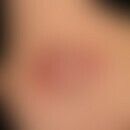Synonym(s)
HistoryThis section has been translated automatically.
Freudenthal and Weber, 1937; Zak, 1950
DefinitionThis section has been translated automatically.
Reticulohistiocytoma is a very rare, benign growth of the skin that usually presents as a solitary nodule or nodule of rare multiples. The tumor has been described primarily as a giant cell variant of dermatofibroma. In no way should this clinical picture be considered a minus variant of multicentric reticulohistiocytosis. The tumor is benign and the diagnosis is usually an incidental histologic finding.
You might also be interested in
ManifestationThis section has been translated automatically.
The tumor is observed mainly in young adults.
LocalizationThis section has been translated automatically.
Mainly the torso, but also the head and neck.
ClinicThis section has been translated automatically.
Reticulohistiocytoma occurs in >90% as a solitary, monoorganic, clinically unspectacular, solid nodule (papule) that rarely exceeds 1.0cm in size.
The tumor is clinically indistinguishable from epithelial tumors, e.g., a keratoacanthoma or a hidradenoma.
A generalized variant is very rare.
A systemic involvement seems to be rather unlikely but cannot be excluded. A displacing growth in the orbit has been described several times (Alzahem T et al. 2021).
To what extent the tumor is characterized by a particular incident light microscopic feature remains to be seen (Behera B et al.2018).
HistologyThis section has been translated automatically.
Reticulohistiocytoma is characterized by mononuclear, occasionally multinucleated macrophages with eosinophilic, "milk glass-like" cytoplasm (oncocytic macrophages). The immunohistochemical profile of a reticulohistiocytoma shows consistent positive expression for CD68 (a marker expressed by histiocytes but may also show positive staining in melanoma and carcinoma), CD163 (a very specific marker for histiocytes), and vimentin. Reticulohistiocytomas show variable positive expression for MITF (microphthalmia transcription factor) and S100 protein, both of which are more commonly used as markers for melanocytes (Cohen PR et al. 2014).
DiagnosisThis section has been translated automatically.
Differential diagnosisThis section has been translated automatically.
Keratoacanthoma
Basal cell carcinoma
Granuloma faciale
Hidradenoma
Solitary trichoepithelioma
Solitary neurofibroma
TherapyThis section has been translated automatically.
In general, excision is curative. It is the therapy of choice. Recurrences are rare.
Progression/forecastThis section has been translated automatically.
LiteratureThis section has been translated automatically.
Alzahem T et al (2021) Solitary reticulohistiocytoma: a rare ocular surface mass. Can J Ophthalmol 56: e64-e66.
- Arico M et al (2003) Histiocytic disorders. Hematol J 4: 171-179
- Behera B et al (2018) Crown vessels and follicular white dot: New dermoscopic findings in a case of solitary reticulohistiocytoma. J Am Acad Dermatol 78:e57-e59.
- Cohen PR et al.(2014) Adult-onset reticulohistiocytoma presenting as a solitary asymptomatic red knee nodule: report and review of clinical presentations and immunohistochemistry staining features of reticulohistiocytosis. Dermatol Online J 20:doj_21725. PMID: 24656263.
- Dehner LP (2003) Juvenile xanthogranulomas in the first two decades of life: a clinicopathologic study of 174 cases with cutaneous and extracutaneous manifestations. Am J Surg Pathol 27: 579-593
- Li-quiang Zhen (2015)solitary orange-yellow lesion on the head. JDDG 13: 468-471
- Weber FP, Freudenthal W (1937) Nodular non-diabetic cutaneous xanthomatosis with hypercholesterolemia and atypical histologiic features. Proc R Soc Med 30: 522-526.
- Zak FG (1950) Reticulohistiocytoma (ganglioneuroma) of the skin. Br J Dermatol 62: 351-355.
Incoming links (7)
Dermatofibroma; Giant cell histiocytoma; Giant cell histiocytoma; Granuloma, reticulohistiocytic; Pleomorphic fibroma; Pseudosarcoma of the skin; Reticulohistiocytoma;Outgoing links (5)
Cd163; Cd68; Dermatofibroma; Juvenile xanthogranuloma; Reticulohistiocytosis multicenter;Disclaimer
Please ask your physician for a reliable diagnosis. This website is only meant as a reference.







